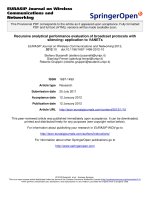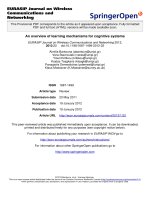Fundamentals of Wireless Communication
Bạn đang xem bản rút gọn của tài liệu. Xem và tải ngay bản đầy đủ của tài liệu tại đây (270.09 KB, 20 trang )
EE 290S: Fundamentals of Wireless Communication
Course Notes
U.C. Berkeley Fall 2002
Instructor: David Tse
Co-written with: Pramod Viswanath
September 18, 2002
Chapter 3
Point-to-Point Communication:
Detection, Diversity and Channel
Uncertainty
In this chapter we look at various basic issues that arise in communication over fading
channels. We first start with analyzing uncoded transmission in a narrowband fading
channel. We study both coherent and non-coherent detection. We see that in both
cases, the error probability performance is very poor compared with that in an non-
faded AWGN channel. The basic reason is because there is a significant probability that
the channel is in a deep fade. This motivates us to look at various diversity techniques
which improve upon this performance. The diversity techniques discussed operate over
time, frequency or space, but the basic idea is the same. By sending signals that carry
the same information through different paths, multiple independently faded replicas of
data symbols can be obtained at the receiver end and more reliable reception can be
achieved. Finally, we study the impact of channel uncertainty on the performance of
diversity combining schemes. We will see that in some cases, having too many diversity
paths can have an adverse effect due to channel uncertainty.
The emphasis of this chapter is on concrete techniques for communication over
fading channels to familiarize ourselves with the basic issues. In Chapter 4 we take a
more fundamental and systematic look and use information theory to derive what is
the best performance one can achieve.
3.1 Detection in a Rayleigh Fading Channel
3.1.1 Noncoherent Detection
To understand the basic issues in communicating over wireless channels, we start with
a very simple detection problem in a fading channel. For simplicity, let us assume a flat
32
fading model where the channel can be represented by a single discrete-time complex
filter tap h[0, m], which we abbreviate as h[m]:
y[m] = h[m]x[m] + w[m], (3.1)
where w[n] ∼ CN (0, N
0
). We assume Rayleigh fading; i.e. h[m] ∼ CN (0, 1), where
we normalize the variance to be 1. For the time being, however, we do not specify
the dependence between the fading coefficients h[m]’s at different times m nor do we
assume any prior knowledge the receiver has of h[m]’s. (This is sometimes called
non-coherent communication.)
First consider binary antipodal signaling with amplitude a, i.e. x[m] = ±1, each
with probability 1/2, and {x[m]} is iid. This signaling scheme fails completely, even in
the absence of noise, since the phase of the received signal y[m] is uniformly distributed
between 0 and 2π under both hypotheses, and the received amplitude is similarly
independent of the hypothesis. It is easy to see that phase modulation is similarly
flawed. In fact, signal structures must be used in which either different signals have
different magnitudes, or coding between symbols is used.
Next consider a form of binary pulse-position modulation where, for each pair of
time samples, either transmit
x
A
:=
x[0]
x[1]
=
1
0
(3.2)
or
x
B
=
0
1
. (3.3)
Note that this is a simple form of orthogonal modulation. We would like to perform
detection based on:
y :=
y[0]
y[1]
This is a simple hypothesis testing problem, and it is straightforward to derive the
MAP (maximum a posterior) rule:
Λ(y)
ˆ
H=0
≥
<
ˆ
H=1
0,
where Λ(y) is the log likelihood ratio:
Λ(y) := ln
f(y|H
0
)
f(y|H
1
)
(3.4)
33
and f (y|H
i
) is the probability density function of y given hypothesis H
i
. It can be
seen that given H
0
, y[0] ∼ CN (0, a
2
+ N
0
) and y[1] ∼ CN (0, N
0
) and y[0], y[1] are
independent. Similarly, given H
1
, y[0] ∼ CN (0, N
0
) and y[1] ∼ CN (0, a
2
+ N
0
) and
y[0], y[1] are independent. Hence the likelihood ratio can be computed to be:
Λ(y) =
{|y[0]|
2
− |y[1]|
2
} a
2
(a
2
+ N
0
)N
0
. (3.5)
The optimal rule is simply to decide H
0
if |y[0]|
2
> |y[1]|
2
and decide H
1
otherwise.
Note that the rule does not make use of the phases of the received signal, since the
random phases of the channel gains h[0], h[1] render them useless for detection. Geo-
metrically, we can interpret the detector as projecting the received vector y onto each
of the two possible transmitted vectors x
A
and x
B
and comparing the energies of the
projections. Thus, this detector is also called an energy or a square-law detector. It is
somewhat surprising that the optimal detector does not depend on how h[0] and h[1]
are correlated.
We can analyze the error probability of this detector. By symmetry, we can assume
that H
0
is the correct hypothesis. Under H
0
, y[0] and y[1] are independent circular
symmetric complex Gaussian random variables with variances a
2
+ N
0
and N
0
respec-
tively. As shown in the exercises , |y[0]|
2
,|y[1]|
2
are therefore exponentially distributed
with mean a
2
+N
0
and N
0
respectively.
1
. The probability of error can now be computed
by direct integration:
p
e
= P
|y[0]|
2
> |y[1]|
2
|H
1
=
2 +
a
2
N
0
−1
. (3.6)
We can define:
SNR :=
a
2
N
0
as the average received signal to noise ratio per dimension.
2
Then the error probability
is:
p
e
=
1
2 + SNR
. (3.7)
This is a very discouraging result. To get an error probability p
e
= 10
−3
would
require SNR ≈ 1000 (30 dB). Stupendous amounts of power would be required for
more reliable communication.
Before we explore further the root cause of the poor performance of this detector,
we note that there are other ways to perform noncoherent modulation and detection.
1
Recall that a random variable U is exponentially distributed with mean µ if its pdf is f
U
(u) =
1
µ
e
−u/µ
.
2
Whenever we refer to “dimension”, we implicitly mean a complex dimension. We will also use
the term “degree of freedom” interchangeably with “dimension”.
34
Here, we did not assume any relationship between consecutive channel gains, but if we
assume that they do not change much from symbol to symbol, differential phase shift
keying (DPSK) can be used to convey information in the relative phases of consecutive
transmitted symbols. The performance of DPSK is analyzed in the exercises.
3.1.2 Coherent Detection
Why is the performance of the detector so bad? It is instructive to compare its per-
formance with detection in AWGN channel without fading:
y[m] = x[m] + w[m]. (3.8)
For antipodal signaling (BPSK) , x[m] = ±a, the error probability is easy to compute:
p
e
= Q
a
N
0
/2
= Q
√
2SNR
, (3.9)
where Q(·) is the complementary cumulative distribution function of a N(0, 1) random
variable. It is known that Q(x) decays exponentially with x; more specifically,
1
√
2πx
1 −
1
x
2
e
−x
2
/2
< Q(x) < e
−x
2
/2
, x > 1. (3.10)
Thus, the detection error probability decays exponentially in SNR in the AWGN chan-
nel while it decays only inversely with the SNR in the fading channel. To get error
probability of 10
−3
, one only needs an SNR of about 7 dB in an AWGN channel.
Compared to detection in the AWGN channel, the detection problem considered in
the previous section has two differences: the channel gains h[m]’s are random, and the
receiver is not assumed to know them. Suppose now that the channel gains are tracked
at the receiver so that they are assumed to be known at the receiver (but they are still
random). In practice, this is done either by sending a known sequence (called a pilot
or training sequence) or in a decision directed manner. The accuracy of the tracking
depends of course on how fast the channel varies. For example, in a narrowband 30kHz
system (such as IS-136) with a Doppler spread of 100Hz, the coherence time T
c
is 300
symbols and in this case there should be plenty of time to estimate the channel with
minimal overhead expended in the pilot.
3
For our purpose here, let us assume the
channel estimates are perfect.
Knowing the channel gains, coherent detection of BPSK can now be performed on
a symbol by symbol basis, exactly as in the AWGN case other than a scaling by the
3
The channel estimation problem for a broadband system with many taps in the impulse response
is more difficult; see Section 3.4.2.
35
channel gain at the receiver. If the transmitted symbol is x[0] = ±a, then for a given
value of h[0], the error probability of detecting x[0] is:
Q
a|h[0]|
N
0
/2
= Q
2|h[0]|
2
SNR
(3.11)
We average over the random gain h[0] to find the overall error probability. For Rayleigh
fading when h[0] ∼ CN (0, 1), we find:
p
e
= E
Q
2|h[0]|
2
SNR
=
1
2
1 −
SNR
1 + SNR
. (3.12)
(See the exercises.) Figure 3.1 compares the error probabilities of coherent BPSK and
noncoherent orthogonal signally over the Rayleigh fading channel, as well as BPSK over
the AWGN channel. We see that while the error probability for BPSK over AWGN
channel decays very fast with the SNR, the error probabilities for the Rayleigh fading
channel are much worse, whether the detection is coherent or noncoherent. In fact, for
high SNR, the error probability for coherent BPSK is:
p
e
≈
1
4SNR
, (3.13)
which also decays inversely proportional to the SNR, as in the noncoherent orthogonal
signaling scheme (c.f. (3.7)). There is a 6 dB difference between the two schemes.
Thus, we see the main reason why detection in fading channel has poor performance
is not because of the lack of knowledge of the channel at the receiver. It is due to the fact
that there is a significant probability that the channel is very poor. More specifically,
by inspecting (3.11), we see that errors occur with significant probability when the
channel gain |h[0]|
2
is of the order or less than 1/SNR. At high SNR,
P
|h[0]|
2
< 1/SNR
≈ 1/SNR (3.14)
and so this latter event occurs with probability approximately 1/SNR. When the
channel gain is much larger than 1/SNR, the conditional error probability decays very
rapidly, exponentially in |h[0]|
2
SNR. Thus, at high SNR, the typical way for errors
to occur is when the channel gain is small, of the order or less than 1/SNR, rather
than when the additive noise is large, which occurs much more rarely because of the
exponential tail of the Gaussian. In contrast, in the AWGN channel the typical and
indeed the only possible way for errors to occur is for the additive noise to be large.
Thus, the error probability performance over the AWGN channel is much better.
The approximate analysis above seems pretty hand-waving, but can in fact be made
precise. (See the exercises. ). Even though the error probability p
e
can be directly
computed in this case, the approximate analysis provides much more insight as to how
36
−10 −5 0 5 10 15 20 25 30 35 40
10
−15
10
−10
10
−5
10
0
SNR (dB)
p
e
BPSK over AWGN
Non−coherent orthogonal signaling
Coherent BPSK
Figure 3.1: Performance of coherent BPSK vs noncoherent orthogonal signaling over
Rayleigh fading channel vs BPSK over AWGN channel.
37
typical errors occur. Understanding typical error events in a communication system
often suggest how to improve it. Moreover, the approximate analysis gives some hint
as to how robust the conclusion is to the Rayleigh fading model we assumed. In fact,
the only aspect of the Rayleigh fading model that is important to the conclusion is the
fact that P{|h[0]|
2
< } is proportional to for small. This holds whenever the pdf
of |h[0]|
2
is positive and continuous at 0.
3.1.3 Diversity
We see from the above coherent detection example that the root cause of the poor
performance is that reliable communication depends on the strength of a single signal
path, and with significant probability that path will be in a deep fade. A natural
solution to improve the performance is to ensure that the information symbols pass
through multiple signal paths, each of which fades independently, such that reliable
communication is possible as long as some of the paths are strong. This technique is
called diversity, and it can dramatically improve the performance over fading channels.
There are many ways to obtain diversity. Diversity over time can be obtained via
coding and interleaving: information is coded and the coded symbols are dispersed over
time in different coherence periods so that different parts of the codewords experience
independent fades. Analogously, one can also exploit diversity over frequency if the
channel is frequency-selective. In a system with multiple transmit or receive antennas
spaced far enough apart, diversity can be obtained over space as well. In a cellular
network, macrodiversity can be exploited by the fact that the signal from a mobile
can be received at two base-stations. Since diversity is such an important resource, a
wireless system typically uses several means of diversity. We will see that although the
basic principle of achieving diversity is the same in the different modes, specific issues
arise that are peculiar to particular modes of diversity.
We will survey several diversity techniques in the next few sections. The simplest
diversity schemes are based on repetition coding: the same information symbol is trans-
mitted over several signal paths. While repetition coding achieves a diversity gain, it is
usually quite wasteful of degrees of freedom of the system. More sophisticated schemes
can increase the data rate and achieve a coding gain beyond the diversity gain.
3.2 Time Diversity
Time diversity is achieved by averaging over the fading of the channel over time.
Typically, the channel coherence time is of the order of 10’s to 100’s of symbols and
therefore the channel is highly correlated across consecutive symbols. To ensure that
the coded symbols are transmitted through independent or nearly independent fading
gains, interleaving of codewords is required. For simplicity, let us consider a flat fading
38







![godara, lal chand - crc handbook of antennas in wireless communications [2002]](https://media.store123doc.com/images/document/14/ri/si/medium_cL3g7P9GyO.jpg)

